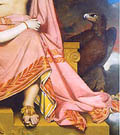| |
| |
THIS MONTH'S PAINTING
Jupiter and Thetis, Jean Auguste Dominique Ingres (1780-1867)
In 1811, whilst still a young student at the Académie de France in Rome, Ingres finished this monumental painting entitled 'Jupiter and Thetis', which he presented at the Paris Salon the following year. The work was a reply to the harsh criticism which his portrait of Napoleon had received at the Salon of 1806.
© Photo RMN

|
|
|
| |
MAURICE CATINAT, CHEVALIER OF THE LEGION D'HONNEUR
On Tuesday 7 February, 2006, Maurice Catinat, trustee of the Fondation Napoléon was made chevalier (knight) of the Légion d'honneur. The award made presented to him at the Château de Malmaison by General Combette, President of the Society of the Friends of Malmaison (Société des amis de Malmaison).
© Chanteranne

|
|
|
| |
200 YEARS AGO
On 12 February, 1806, Napoleon sent a note to Portalis, Minister of Religions (ministre des Cultes), asking him to diminish the number of 'holy' days, since they «distracted the people from their work». Only two were to be continued: the 15th of August, Saint Napoléon's day, instituted in 1805, from a Frenchified version of a certain Roman Saint Neopolis, a martyr who died in prison in Alexandria in the 4th century. The 15th of August would thus be a celebration of the emperor's birthday and the Pope's signature on the Concordat. «In addition to this holy day, thanksgiving should be offered for the prosperity of the Empire» on the first Sunday following the 11 Frimaire (2 December) in celebration of the success of the Grande Armée at Austerlitz and the coronation. «Special mention should be made of the citizens of the regions concerned who may have died at the Battle of Austerlitz».
Correspondence n°9803
On 13 February, 1806, in a letter to Pope Pius VII, Napoleon informed the pontiff that : «the whole of Italy will be put under my law. […] Your Holiness should have for me, in temporal matters, the same respect which I bear you in terms of spiritual things […]. Your Holiness is sovereign of Rome, but I am its Emperor. All my enemies must be yours».
This letter needs to be seen in the context of the previous correspondence of between the pontiff Pius VII and the Emperor of the French. After the French occupation of Ancona in central eastern Italy, itself a key port of the Papal States, Pius VII, had written a bitter letter of complaint to Napoleon on 13 November 1805. Pius even went so far as to threaten the expulsion of the French minister to the Vatican. Napoleon's reply of 7 January (see Letter 354) was a brusque call to order. This second letter was possibly even more worrying for the pontiff in that it underlined the Realpolitik state of affairs regarding the Papal States: in political terms, the State of Rome could only preserve its existence under the suzerainty of France. Indeed, in the famous letter to Cardinal Fesch, also written on 7 January (and which Napoleon had instructed be shown to the Vatican) the emperor noted [Correspondence 9656] “For the Pope, I am Charlemagne, because, like Charlemagne I have combined the crown of France with that of the Lombards, and because my empire borders the Orient.” Since Charlemagne had give the Papal States to the pontiffs in 8th century (the famous Donation of Charlemagne of 774 and 781), Napoleon as a second Charlemagne felt that temporal power of these lands was rightly his.
Correspondence n°9805
13 February, 1806: Napoleon visited the Panthéon. Astounded that despite the repair work which had been decided upon in the spring of 1805 the church was still in a ruinous state, he passed a decree (20 February, 1806) ordering that the work be completed and the building be returned to the Catholic church. Furthermore, the site was to keep the role given it in 1791 - when it had been renamed 'Temple to the Nation' - namely, a place of burial for 'great men'. Indeed, the decree outlined that building was to be for «the tombs of all the French people who, in whatever career, were of benefit to the patrie (fatherland)». 6,000,000 francs were granted for the completion of the work. The newspapers also reported on Napoleon's decision that «the church of Saint-Denis would be returned to it ancient role» namely that «this church should consecrated as the place of burial for the princes of the French monarchy». Four chapels were to be built, one each for the three previous dynasties (The Merovingians, the Carolingians and the Capetians) and one for the fourth dynasty, that of the Bonapartes.
(Journal de l'Empire, 17 February, 1806).
Wishing you an excellent, Napoleonic, week.
Peter Hicks
Historian and Web editor
THE NAPOLEON.ORG BULLETIN, No 359, 10 - 16 February, 2006
Interested in the work of the Fondation Napoléon? Why not participate, either generally or in a specific project, by making a donation.
© this Napoleon.org weekly bulletin is published by the Fondation Napoléon. Reproduction or all or part of this bulletin is forbidden, without prior agreement of the Fondation Napoléon.

|
|
|
|
|
|
|
|
|
|
|
|
|
|
THIS WEEK in the MAGAZINE
WHAT'S ON
Guided tours:
- Napoleonic Milan, Italy
Fairs:
- The 13th International Napoleonic Fair, St Albans, UK
- National Living History Fayre, Warwickshire Exhibition Centre, near Royal Leamington Spa, UK
Re-enactments:
- Napoleon at Golfe-Juan 2006: 11th re-enactment of the emperor's landing
Book presentations:
- Lucca, Sergio Valzania is to present his book Austerlitz - La più grande vittoria di Napoleone
- Lucca, Bruno Mugnai is to present his book Soldati e milizie lucchesi dell'ottocento
Conferences and Talks:
- International conference, Delft, Netherlands
- 2006 Consortium on the Revolutionary Era, 1750-1850, Atlanta, USA
Exhibitions:
- Napoléon an intimate portrait, Tallahassee, Florida, USA
- Napoleone and Bodoni, Parma, Italy
- "Battle in a sittingroom." The Austerlitz wallpaper, Museo Napoleonico, Rome, Italy
- In the Service of Napoleon. The Dutch in time of War 1792-1815, Delft, Netherlands
- Napoleon on Campaign, the emperor's bivouac, at the Arc de triomphe de l'Etoile, Paris, France
- Napoleone e il Piemonte. Capolavori ritrovati, Alba, Italy
Entertainments:
- Thursdays at the Museum of Florida History, Tallahassee, Florida, USA
Got a problem with the letter? Try the home page: http://www.napoleon.org<<
|
|


